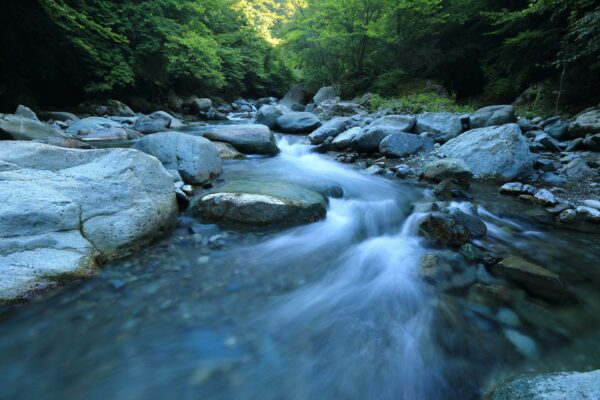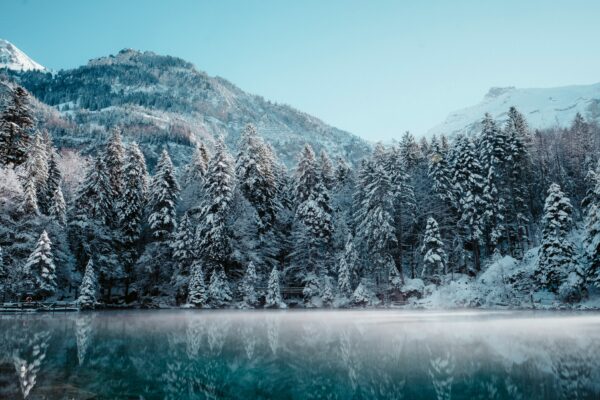-
con·tain /kənˈtān/: to have or hold within; to control or restrain (oneself or a feeling)
According to Classical Chinese symbolism, winter is associated with the qualities of water 水 (shuǐ) and the Kidney organ network. This means that the energetic gestures behind these facets are practically synonymous.
During this time of year, the external world is motionless while yang is active and concentrated deep beneath the surface. Nature is cold and dark; the movement of life is hidden. We are in-between the previous cycle of life and the next one. When droplets of water move down a river, they have no idea where they’re headed. Likewise, amidst the winter stillness, there is inevitable contact with the unknown as we can’t see where life is moving. As we encounter the unknown, naturally we come into contact with one of two gestures which belong to the water element: surrender or fear.
If we go deep into any fear, we’ll often find that a fear of death is at the root. Death is our greatest encounter with the unknown. We do not know what is on the other side of it as we leave behind all material attachments, yet it is inevitable and during its process there is nothing we can do except surrender to it.
The illusion of knowing things for certain gives us a false sense of control which functions to shut down our fear of the unknown. In our modern context, reductionism is our collective thought process as we attempt to look through complex interwoven structures and understand things in their simplest, most reduced forms – asserting that all phenomena must be rationally measurable within the parameters of our perception. Our modern approaches to science and medicine mirror this. Many of us have a hard time holding that multiple nuanced truths can actually exist at once; truth is dynamic rather than linear as is life. Some facets of life are simply mysterious and beyond our domain of control. Unless we integrate this, we are partially living under a delusion that exists to offset our own fear of death.
On the flip side of the fear of death is an awe of the world around us. Within awe lives an acceptance that there is a limit to material existence. If I perceive in every moment that what is before me will someday come to an end, then I am continuously living in awe and appreciation of life. When I take life for granted, I lose touch with that awe. Awe is a gesture of the Kidney and water element.
An antidote to fear is the deep embodied wisdom that life will continue to endure far after things lose their present form, including ourselves. Within water is the simultaneous integration of the unavoidable mystery of life and its limitations, and the surrender of ourselves to something greater than the form we are confined to. Metal, associated with autumn, is in touch with an inspired and expansive connection to something greater than ourselves. Water, associated with winter, roots this inspiration down into an embodied knowing that we are connected to the greater cycle of life; we share the same source as every living facet around us. In nature, water has been recycled again and again to support life after life, and we are a part of that cycle.

The Kidney is a vessel for connection to the life that came before us and the life that will continue after us: our ancestors and our children. It is likewise tied to our genetics. A healthy Kidney equates to strong teeth, dense bones and a solid immune system which we were born with. Likewise, the Kidney is connected to fertility, reproduction, and our will. It is linked to the structure which holds us upright and the strength that keeps us moving; physical endurance and mental resilience. Pain of the lower body (ankles, hips, knees, lower back) involves the Kidney in some respect, as does whether we move with fluidity or rigidity.
At this time of year, the resources in the outer world are diminished so we are reliant upon our own resources and will to survive. Likewise, the gesture of the Kidney is to store and contain. It contains our literal physical limitations and our life battery. In Chinese Medicine, we call this battery jing essence and it is a non-renewable resource. Everything we do in life consumes jing. As we age, jing naturally declines and our bones lose density, our skin wrinkles, and our fluids decrease. In life, we assert our will and choose what to expend our limited energy on; we decide what will age us.
The house is a symbol of the Kidney. Our ancestors originally built homes to shelter themselves safely from the outside world. They created a material container within which to possess comfort, safety, and to store their resources. Whatever happens inside of houses is self-contained and hidden from the outer world, much like the activity of yang in the winter.
To understand the Kidney, we can look symbolically to Virgo on the astrological wheel. Virgo is an earth sign that sits between fixed Taurus and initiatory Capricorn. Taurus is the fertile ground of life and pleasure in the warm and stable spring, and Capricorn is deep within the cold winter where the reality of death is clear and self-reliance is paramount. Here at Virgo, the mutable position in the middle, we hold two mercurial truths at once: life is pure, beautiful and astonishing (awe), and death is imminently approaching (reality and fear of limitations). We need to preserve our resources so that life can continue, as we do not want to be left out in the cold to die. This is the gesture of the Kidney in the body: containing, concentrating, and preserving our internal resources. Grasping oxygen from the blood to recycle it as energy, managing salt so that the metabolism of water moves fluidly in the body without dissolving all of our boundaries.
Water relates to our self-possession, the boundaries of who we are and whether our sense of self is clear and contained or muddled into confusion. Manifestations of this theme are dissociation, shame, a fear of being seen, arrogance and disdain.
Water is essential to life. Civilizations were formed around rivers and streams. Within water lies both deep stillness and continuous movement, the appearance of death and the stirring of new life, our physical container and the eternal flow of life that lies beyond it. Water can be both the most gentle facet of nature and the most powerfully destructive.
Surrendering to what lies beyond the known form is an undertaking of water. When we are aware of our limits, we don’t waste our energy fulfilling endeavors that are beyond our means. And when we detach from outcomes and remove our will from the equation, we have less pressure and we find greater peace. Deep within water, there lies peace. We can rest in that peace, in the deep stillness of winter. At this time of year, remove the pressure on yourself to initiate everything you desire. That gesture belongs to the spring. Instead, be within the steadiness. Sustain yourself, but let things come and go without attaching to them. Life is stirring quietly beneath the surface while nature above is at rest with less external demands. Wouldn’t it be peaceful if you were too?


Leave a Reply